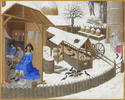The last thing this polarized Republic needs is, well, more polarization, but that is what we are contracting from the pandemic. Americans, irrespective of region, broadly want the same things, such as safety, a return to normalcy, and an end to dependence on China for medical supplies, but they differ in the depth of their experiences with the pandemic. read more »
Deindustrialization as a Template for COVID-19
As we wrote in Steeltown USA: Work and Memory in Youngstown, Youngstown’s story is America’s story, and that city offers a useful case study for anyone trying to imagine American life after the pandemic. No doubt, coronavirus is a natural disaster that is more contagious, widespread, and deadly than the economic disaster of deindustrialization. read more »
On the Seasonality of the Virus
What are the odds that the coronavirus will recede on its own during the spring because of warmer temperatures or a higher ultraviolet (UV) index? This has been a question from the beginning.
There has been some research in support of the idea that the warmer season would force the virus to retreat. And there has been other research that concluded that the virus would retreat but not disappear, that it would survive in the southern hemisphere and that it could then stage a comeback in the northern hemisphere in the fall when cooler temperatures return. read more »
- Login to post comments
Rethinking the Social Safety Net
The COVID-19 epidemic wreaked havoc on the majority of American households. The USC Dornsife poll reported on April 17th that 15% of previously employed people in the country have lost their jobs because of the virus. That translates into close to 26 million newly unemployed. While many of those jobs will come back once we get through this, I do not think all of them will. Future social distancing rules will, for instance, limit the number of patrons a restaurant or a bar can serve. Fewer customers means fewer employees to serve them. read more »
- Login to post comments
Dispersion in US Metros Increases Even Before COVID-19: New Census Estimates
The latest US Census Bureau metropolitan area population estimates (for 2019) were largely lost in the coverage of the COVID-19 pandemic. read more »
- Login to post comments
The Pandemic Road to Serfdom
Even before the outbreak of the Covid-19 pandemic, America, like most higher-income countries, was already heading toward a neo-feudal future: massive inequality, ever-greater concentrations of power, and increasingly widespread embrace of a uniform (albeit secular) religion. The pandemic, all too reminiscent of the great plagues of the Middle Ages, seems destined to accelerate this process. read more »
- Login to post comments
Letter from Los Angeles: The Death of Small Business is a Tragedy for Jewish Community and Democracy
“Small-scale commercial production is, every moment of every day, giving birth spontaneously to capitalism and the bourgeoisie…wherever there is small business and freedom of trade, capitalism appears.”— V.I. Lenin read more »
- Login to post comments
Subways Seeded the NYC Epidemic: MIT Economist
Like so many of us, Bret Stephens, an opinion columnist for The New York Times is stunned at the concentration of COVID-19 virus deaths in New York City, as well as the rest of the metropolitan area. In an April 25, 2019 article entitled “America Should Not Have to Play by New York Rules,” Stephens points out that the “number of Covid deaths per 100,000 residents in New York City (132) is more than 16 times what is in America’s next largest city, Los Angeles (8).” read more »
- Login to post comments
The Coronavirus Means You May Have Seen Your Last Skyscraper, New York
While Gov. Andrew Cuomo has warned that “we are your future,” since “what happens to New York is going to wind up happening to California and Washington state and Illinois” and the New York Times has blared that "This Is Going to Kill Small-Town America," the COVID-19 death rate in the United States appears to be more than twice as high in large urban counties as in high-density suburbs, and nearly twice as high in high-density suburbs than in lower-density ones. read more »
- Login to post comments
Americans Are Not As Divided About the Pandemic As It Seems
As COVID-19 ravages varied regions of the United States at different levels of intensity, news reports have repeatedly shown an ideological split in public opinion over how President Trump is handling this pandemic. read more »
- Login to post comments






















